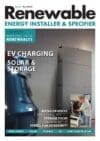
Looking at the current state of the market for renewables I think challenges remain in the short term, but significant opportunities taking a longer view. Midsummer distributes both solar PV and heat pumps, and uptake of both are connected, with some shared issues in the market.
In the domestic retrofit market, mainstream adoption faces hurdles that I remember by a handy acronym, relating to the pace we need to tackle them with: FAST.
Finance: This is increasingly going to be key to unlocking mass uptake. The energy crisis drove huge demand, but the market for those with funds available became saturated – and for many, even with the falling equipment costs, a solar and storage system is out of reach. There is lots of innovation happening in this space, thankfully, with various models for spreading the cost already being rolled out.
That will become much more prevalent (as it is in Germany, for instance). There’s lots of innovation around optimising the smart home controlling assets such as solar, battery storage, a heat pump, EV charger, perhaps smart appliances and thermal storage, and how all of those interact with agile tariffs and grid services – those things affect the finances enormously too.
Access: For many homeowners considering solar as part of a wider home upgrade with the complexities mentioned above, knowing where to get advice is really difficult. Many brands are ones they won’t have heard of, and impartial advice can be hard to come by. Finding installers, and knowing how to compare them can also be challenging.
There are some great organisations working on this, and it’s something we’re working to address as well.
Skills: During the period of heightened demand, there was a shortage not only of products, but also of skilled installers able to fit them. While a large number of people have joined the solar industry in the last year, this adds pressure to the training and certification bodies, and that has been a bottleneck. It’s more pronounced in the renewable heat sector at the moment.
To deliver on the 70GW target for solar, or the 600,000 target for heat pumps, we need to speed up the process of attracting talent and creating a skilled installer base – but without relaxing standards on the one hand, or tying people up in red tape on the other. It’s a difficult balance.
Trust: Some of the most successful organisations selling renewables in this and other markets are those where the organisation itself is known and trusted – it’s uncertain territory and a long term investment.
That can work against the smaller installers, and so any way of empowering homeowners with information, levelling the playing field for installers, but ensuring that nobody vulnerable is being taken advantage of would be a real step forward in the industry. Again, we’re tackling that with our software. That’s quite connected with access, if I’m honest, but I needed my acronym to work 🙂
Other opportunities
There is a great deal of installation happening under ECO4, the Energy Company Obligation scheme, and that will continue for the next couple of years.
The new build sector has been in limbo over the future homes standard and consultation. It’s likely that while it may stimulate demand for heat pumps, it waters down the new build solar requirements. That’s short-sighted – solar and storage are the perfect accompaniment to ASHP for the sake of running costs for tenants. If it isn’t handled at build stage (when it is far cheaper and easier) it will create a retrofit demand after the fact.
Commercial solar is booming, and I can’t see that changing – options for commercial scale storage are increasing all the time too. That will continue to be a growing focus for us this year, we have expanded our commercial team and will continue to.
Will we hit the 70GW 2035 target? The sector is growing well, but needs to be doing so two to three times as quickly to get where we need to be. That means a renewed political will (and perhaps an election may yet deliver that) and engaging with solar at all levels, domestic, commercial, new build, but also the political hot potato of solar farms.
They all have a role to play in getting us there. The electrification of heat shouldn’t be seen as a competitor, since like the transition to EVs, more solar PV is always the answer!
Are you an installer or manufacturer? We’d love to hear about your current experience of the solar PV market, including the challenges and the opportunities. Please get in touch with us by emailing news@renewableenergyinstaller.co.uk.
Image credit: Midsummer Energy



